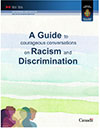This could also be posted in Recruiting.
The Department of National Defence believes Canada's military needs to reflect on "white fragility," according to Blacklock's Reporter.

torontosun.com
Canada's military needs reflection on 'white fragility:' DND
Author of the article:
Postmedia News Published Mar 14, 2023
Canada's military needs reflection on 'white fragility:' DND
Canada's Prime minister Justin Trudeau talks with soldiers during a visit of the Adazi military base, north east of Riga, Latvia, on March 8, 2022. PHOTO BY TOMS NORDE /AFP via Getty Images
The Department of National Defence believes Canada’s military needs to reflect on “white fragility,” according to Blacklock’s Reporter. (Paywall)
“Racism and discrimination still manifests in our workplaces through bias, privilege, policies and power dynamics,” said a companion Guide To Courageous Conversations On Racism And Discrimination, according to Blacklock’s. “The defence team must put compassionate effort into practice to actively become an anti-racist organization. We all have to do the work in shifting mindsets and promoting an inclusive workplace, and acknowledge that together we’re different.
Those in the military must “ask racially and culturally grounded questions about yourself to increase awareness of seen (consciously known), unseen (unknown) and unforeseen (anticipated) issues,” the guide added.
“Consider how history and politics shape or influence your personal experiences and that of colleagues within your organization,” it advised. “Engaging in dialogue is the first step to understanding one another. The goal of these conversations is to raise awareness and consciousness, with hopes that a deeper understanding and empathy will lead to a commitment to shift mindsets and behaviours.”
The military in a 2017 set quotas for recruitment of visible minorities. Military targets state by 2026 the quota must increase from eight to 12%. But the Royal Canadian Air Force Journal in a 2020 commentary said the higher quota was “almost impossible to achieve” due to lack of interest in military careers by minority groups.
Here it is:
Guide for holding respectful conversations about racism and racial discrimination with practical advice on starting, having and closing discussions.

www.canada.ca
Guide to courageous conversations on racism and discrimination
Racism and discrimination still manifests in our workplaces through bias, privilege, policies and power dynamics. The Defence Team must put compassionate effort into practice to actively become an anti-racist organization. We all have to do the work in shifting mindsets and promoting an inclusive workplace and acknowledge that together, we're different.
Use this guide to hold conversations on racism and discrimination that are considerate of all participants, whether or not they belong to a racialized group. It can be consulted to prepare for an initial conversation or ongoing conversations. Committing to a series of conversations from the outset will allow for the time and space to develop a meaningful understanding of issues and concerns.
On this page
Download or print a PDF of the tip sheet:
 Guide to Courageous Conversations on Racism and Discrimination.[PDF - 446 KB]
Guide to Courageous Conversations on Racism and Discrimination.[PDF - 446 KB]
Catalyst for change
In January 2021, the Clerk of the Privy Council Office issued a
Call to Action on Anti-Racism, Equity, and Inclusion which made clear to all federal government departments and agencies that anti-racism is now a public service priority. The time to act to advance anti-racism, equity and inclusion in our organization is now.
So, now what? We need to talk, but not just talk. The time is now for us to have the difficult conversations, talk about the issues, listen to those with lived experiences about what is working and what has not worked. We are in a critical time and this is a business imperative to ensure continued success of our people and our organization.
In planning these courageous conversations, it is important to first acknowledge that there are very real challenges associated with planning a successful discussion on racism. We are all learning and this is a lifelong process. Be prepared to dig deep and think about how you contribute to and whether you challenge racism and discrimination.
Purpose of guide
This resource is meant to increase self-awareness and situational awareness in order to raise and address difficult/uncomfortable issues, and can be used to:
- become more aware of the diversity around you
- create a positive and respectful work environment
- examine your beliefs and experiences related to systemic racism and racial discrimination
This guide offers the Defence Team opportunities to take small steps in creating open dialogue and turning them into meaningful action.
- Listen: hold spaces for colleagues to share their experiences
- Engage: connect and learn from our Defence Team Advisory Groups and Networks
- Acknowledge: recognize your own actions and seek out feedback
- Do the work: challenge behaviours, practices and policies that reinforce racism
Understanding the terminology
Even the most frequently used words in any discussion on race can easily cause confusion, which can lead to controversy and hostility. It is essential to achieve some degree of shared understanding, particularly when using the most common terms. In this way, the quality of dialogue on race can be enhanced.
Below is a list of some commonly used terms to get started with.
Equality
Equal treatment that brings about an equality of results and that may, in some instances, require different treatment. For example, to give all students equal treatment in entering a building, it may be necessary to provide a ramp for a student who uses a wheelchair.
Equity
Equality in access and outcomes and a distinct process of recognizing differences within groups of individuals, and using this understanding to achieve substantive equality in all aspects of a person's life.
Systemic Barrier
A barrier embedded in the social or administrative structures of an organization, including the physical accessibility of an organization, organizational policies, practices and decision-making processes, or the culture of an organization.
Inclusion
Appreciating and using our unique differences – strengths, talents, weaknesses and frailties – in a way that shows respect for the individual and ultimately creates a dynamic multi-dimensional organization.
Privilege
Benefitting from unearned power, benefits, advantages, access and/or opportunities based on membership or perceived membership in a dominant group.
Bias
A subjective opinion, preference, prejudice, or inclination, often formed without reasonable justification, which influences the ability of an individual or group to evaluate a particular situation objectively or accurately. Biases (particularly implicit biases) are built into and perpetuated by societal structures. These biases might be against others’ race, gender, weight, disability, sexuality, skin-tone, age, culture or religion.
You can refer to the
anti-racism lexicon for a comprehensive set of terms and definitions.
Preparing for a conversation
Before you begin, consider the following factors before embarking on initial discussions or conversations.
- What is my level of readiness to hold space for this type of discussion?
- Have I taken the time to assess my own biases, prejudices and privilege?
- Have I taken the mandatory training and other training available?
- Am I aware of the past and present history of racism and racial discrimination in the organization? In this country?
- What is the goal of this conversation?
When we consider our own layers, check our assumptions and ask about inclusion, we can create change and guide our conversations with positive intentions.
Consider layersCheck assumptionsAsk about inclusionReflect
Starting a conversation
Engaging in dialogue is the first step to understanding one another. The goal of these conversations is to raise awareness and consciousness with hopes that a deeper understanding and empathy will lead to a commitment to shift mindsets and behaviours.
Steps to consider when engaging in discussion on racism and discrimination:
- Be clear and open about the purpose of the conversation before inviting people and during the conversation
- Set ground rules for respectful conversation
- Active listening is a must
- Remain open, with curiosity modeled by responding with questions before responding with your own interpretation or explanation of impact in regards to someone else’s comments
- Recognize and acknowledge people’s experiences; the person/people you are in conversation with are bringing their own perspective, shaped by their own experiences (culture, history, practices and upbringing)
- Be mindful to take breaks to re-centre when conversations feel uncomfortable or too wrought with conflict to be productive. Build in moments for deep breathing, pauses to reflect and re-centre, and moments to be aware of mind, body, and emotional alignment
- Everyone has agency, and, regardless of agreement and alignment, everyone is worthy of being valued in the dignity of their humanity
- Don’t assume intent: do centre impact over intent
- Dismantling racism is not a checklist, a meeting, or a one-time commitment; make small, realistic, challenging commitments to grow, learn and evolveFootnote2
BRAVE framework
Creating change through meaningful conversations and choosing to be honest, open and transparent can provide a path forward to building trust and understanding. To help facilitate workplace conversations, this guide will discuss the BRAVE Framework developed by Dr. Enrica N. Rugg and Dr. Derek Avery as an approach to framing conversations about racism and racial discrimination.
BRAVE is an acronym for Build, Respect, Acknowledge, Validate and Emphasize. The BRAVE Framework is a useful tool that guides methods, processes and strategies when having courageous conversations with management and employees at all levels of an organization.
Before you open the conversation, establish why these types of conversations are in everybody's best interest and the importance of assessing/acknowledging where things stand within the workplace.
For example, you could say, "I didn't realize how much I didn't know about race" or "I would like to engage you in a conversation about race in a real and honest way." These kinds of opening statements can set the stage for the kind of dialogue you want to have with your team.
Footnote3
Build
Build the intention, focus, and safety needed to have honest conversations about race.
The result? Don't let a planned conversation derail into a general discussion on diversity and inclusion without touching on concerns specific to race, like psychological safety, loss of employment opportunities.
- Reinforce the purpose of the conversation, which should be to explore, to listen and to learn
- Determine the scope of the conversation: Is this an introductory gloss or a deep dive?
- Determine who takes part in the conversation, whether attendance is mandatory or voluntary, and what questions will be asked
- Provide ground rules to encourage dialogue, active listening and mutual respect. Be sure to write them down and make them visible. Examples include:
- practice active listening
- don't interrupt
- assume good intentions
Respect
Respect the sensitivity of the topic while challenging people to go beyond the superficial. Employees need to respect other people's boundaries.
- The definition of respect can be very personal. Find out what respect means for the group, perhaps through an icebreaker activity
- Encourage follow-up questions rather than jumping on first impressions; make it a standard practice for participants to pause before responding
- Examples include: "I've never thought of that before – could you explain why you think that?"
- Recognize that people with good intentions can make statements that hurt or offend; letting others know how their words affect you is useful
- Examples include: "I feel frustrated (or I feel disrespected) when people say…because…"
- Establish strategies for everyone to participate and be heard
- Put in place a strategy for pausing the conversation should it become unproductive
Acknowledge
Acknowledge the uncomfortable realities of the past and the present.
Take the time to discuss those parts of Canadian history that are in stark contrast to Canada's multicultural brand. For example, slavery, residential schools and the Japanese internment, and the legacy of that history on the political, economic and health outcomes of Indigenous, Black and other racialized groups today.
It's equally important to keep in mind that some people can get uncomfortable thinking about their role in upholding systems of oppression and inequality in the world and in the workplace, but we need to talk about these things for progress to be made.
- Talk about the systemic obstacles to equal opportunity and equal justice
- When we're hoping to show the existence of discrimination or racism by pointing out racially unequal conditions, it's particularly important to tell a full story that links cause (history) and effect (outcome); without this important link, some audiences can walk away believing that our health care, criminal justice or educational systems work fine and therefore, differing outcomes exist because Indigenous, Black and other racialized groups are doing something wrongFootnote4
- Know the counter narratives. Some themes consistently emerge in conversations about race, particularly from those who do not want to talk about unequal opportunity or the existence of racismFootnote5
- While we all probably feel like we know these narratives inside out, it's still important to examine them and particularly to watch how they evolve and change
- The point in doing this is not to argue against each theme, point by point, but to understand what stories are happening in people's heads when we try to start a productive conversation
- A few common themes include:
- Racism is "largely" over or dying out over time
- People of colour are obsessed with race
- Alleging discrimination is itself racist and divisive
- Claiming discrimination is "playing the race card," or that it's opportunistic
- If we can address class inequality, racial inequity will take care of itself
Validate
Validate and accept the experiences of your racially marginalized colleagues. Productive conversation requires acknowledging the reality of racism and racial discrimination.
- Ensure recognition and affirmation of people and their experiences
Emphasize
Emphasize how your organization is prioritizing goals and metrics around racial equity. Conversations should lead somewhere.
BRAVE conversations should include explicit steps for moving toward racial equity:
- Review the Clerk of the Privy Council Call to Action
- Demonstrate your commitment to anti-racism work by explaining the DM Commitments on Diversity and Inclusion and how that impacts your own performance management agreement
- Incorporate various initiatives from your Equity, Diversity and Inclusion Plans in your everyday work
- Network, engage and consult with Defence Advisory Groups and Networks
Closing a conversation
As you reach a point where you feel it is time to close the conversation
Footnote6, consider doing any of the following:
- Extend gratitude to everyone for their courage and willingness to participate
- As the host, share how the experience impacted you and offer space for others to as well. It can be as simple as sharing one word to summarize their feelings about the experience
- Encourage group members to follow up with training and potential mental health resources for self-care
- Some people on the team may be interested in continuing the dialogue one on one outside the scheduled/facilitated discussion: be sure to emphasize, prior to the close of the meeting, that there is a time and place for these conversations and unplanned discussions may not be welcome by team members. It is necessary to ask permission before engaging in these conversations in order to give people an option; this gives everyone, but specifically racialized team members, time to mentally and emotionally prepare as the discussion can be traumatic
- Ask people to share what they learned about themselves or what is their one takeaway from the conversation
Footnotes
Footnote 1
https://www.utoledo.edu/education/programs/documents/social-philosophical-foundations-education/2020-8-10-Baker-Critical-self-reflection.pdf.
Return to footnote1referrer
Footnote 2
Conversation Guide: Talking about Race, Racism, Care, and Caregiving
Return to footnote2referrer
Footnote 3
A 5-part framework for talking about racism at work | MIT Sloan
Return to footnote3referrer
Footnote 4
https://www.opportunityagenda.org/e...-talking-about-race-racism-and-racial-justice
Return to footnote4referrer
Footnote 5
https://www.opportunityagenda.org/e...-talking-about-race-racism-and-racial-justice
Return to footnote5referrer
Footnote 6
https://healourcommunities.org/wp-c...ationGuide_2019_V6_12-10-18-FINAL_proofed.pdf







